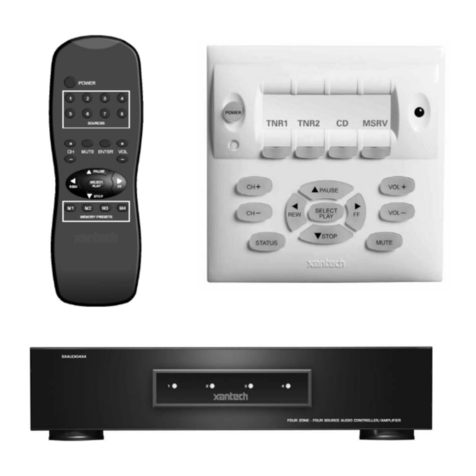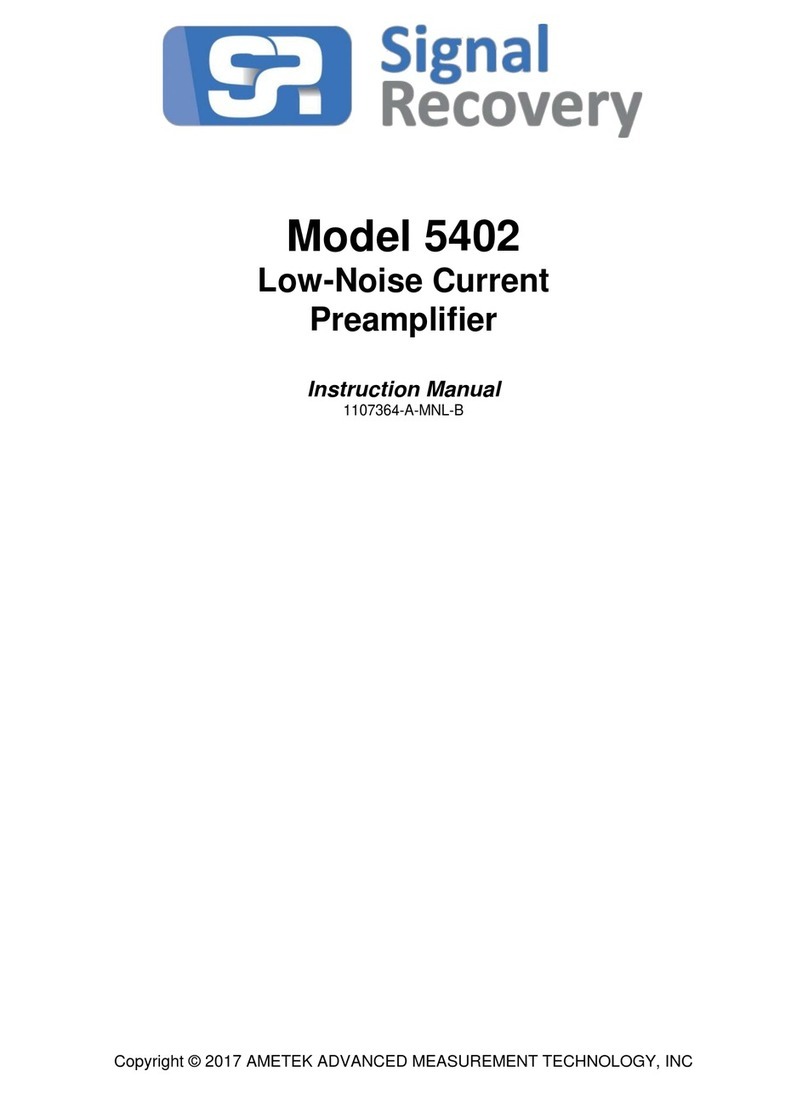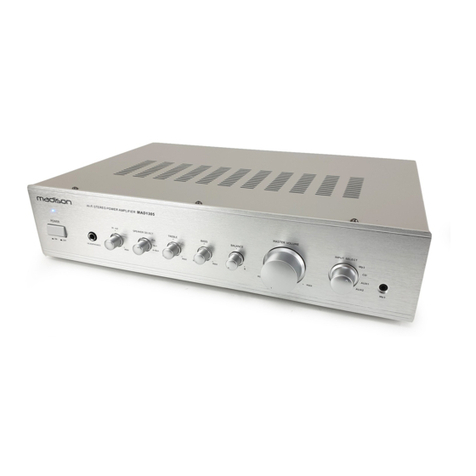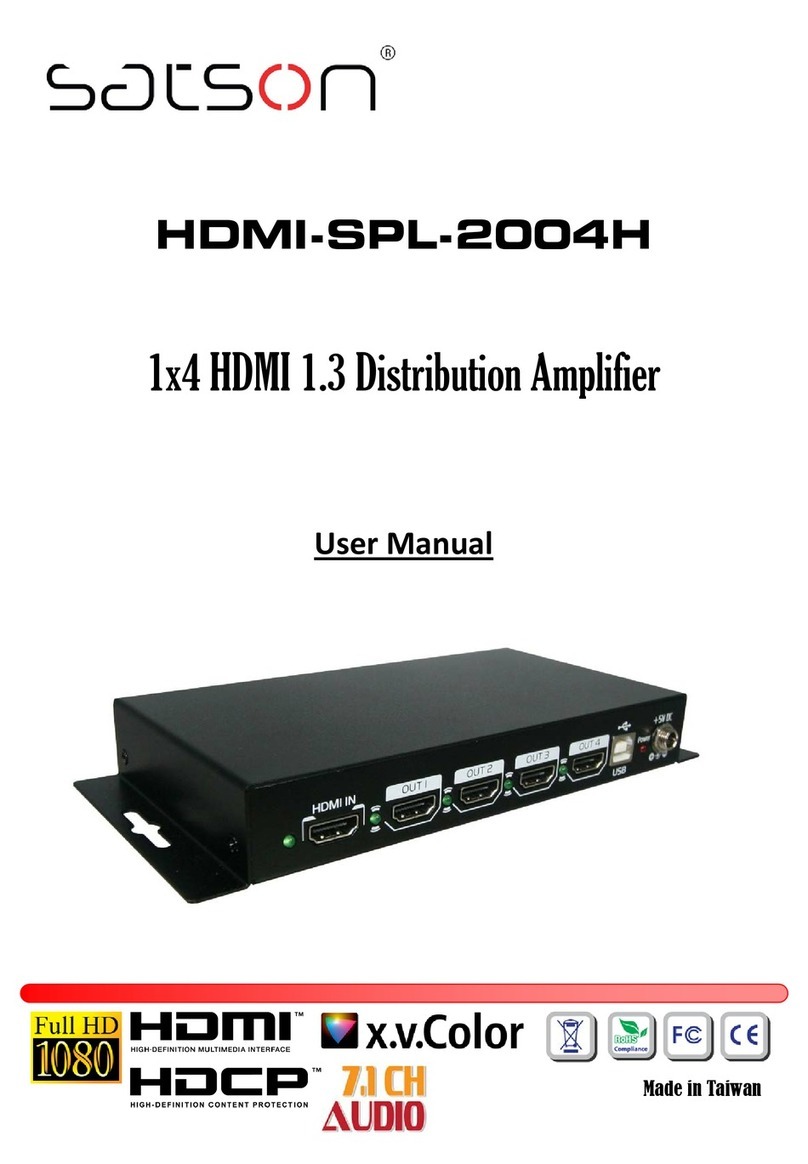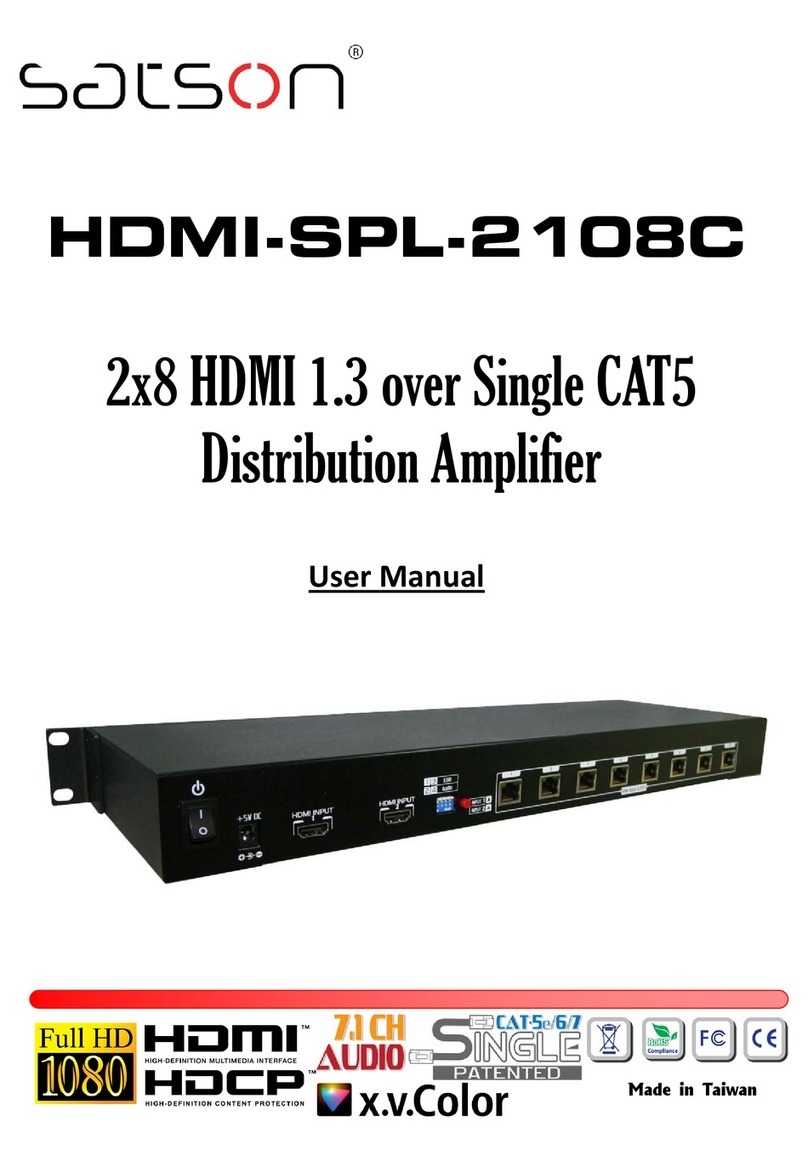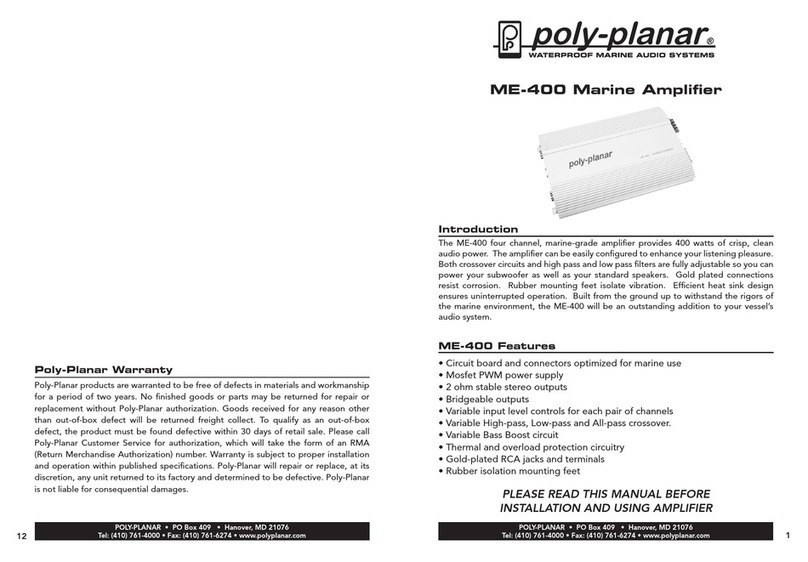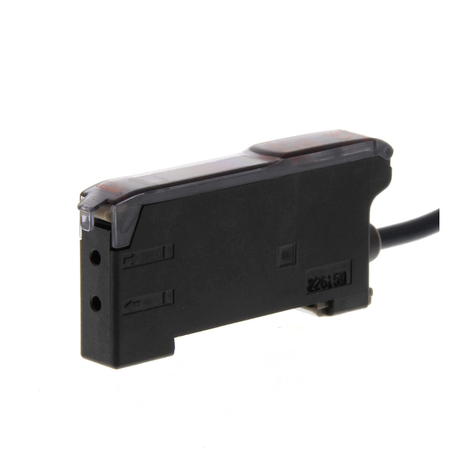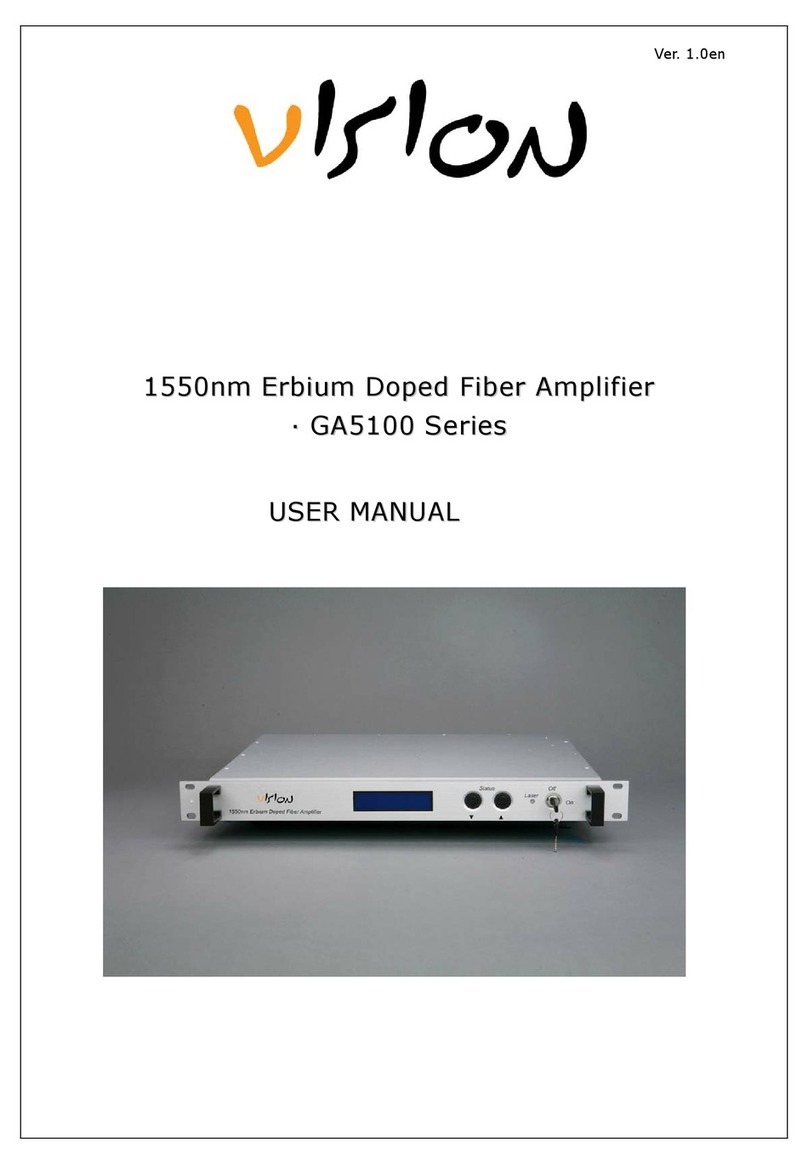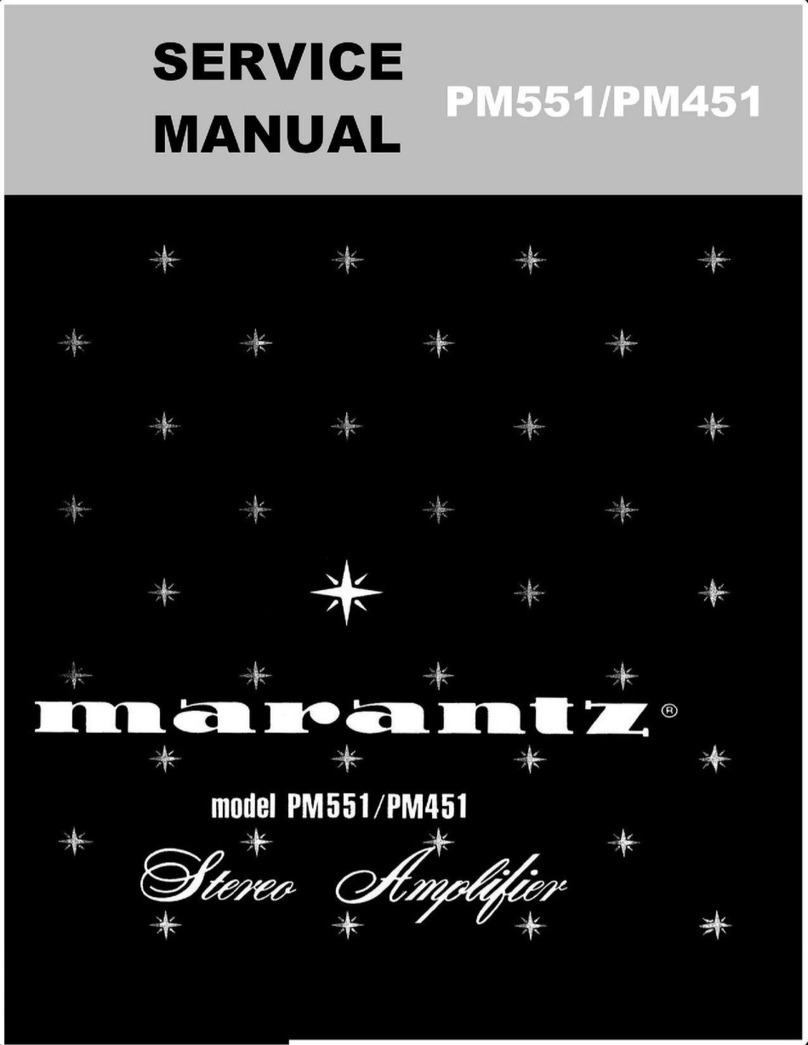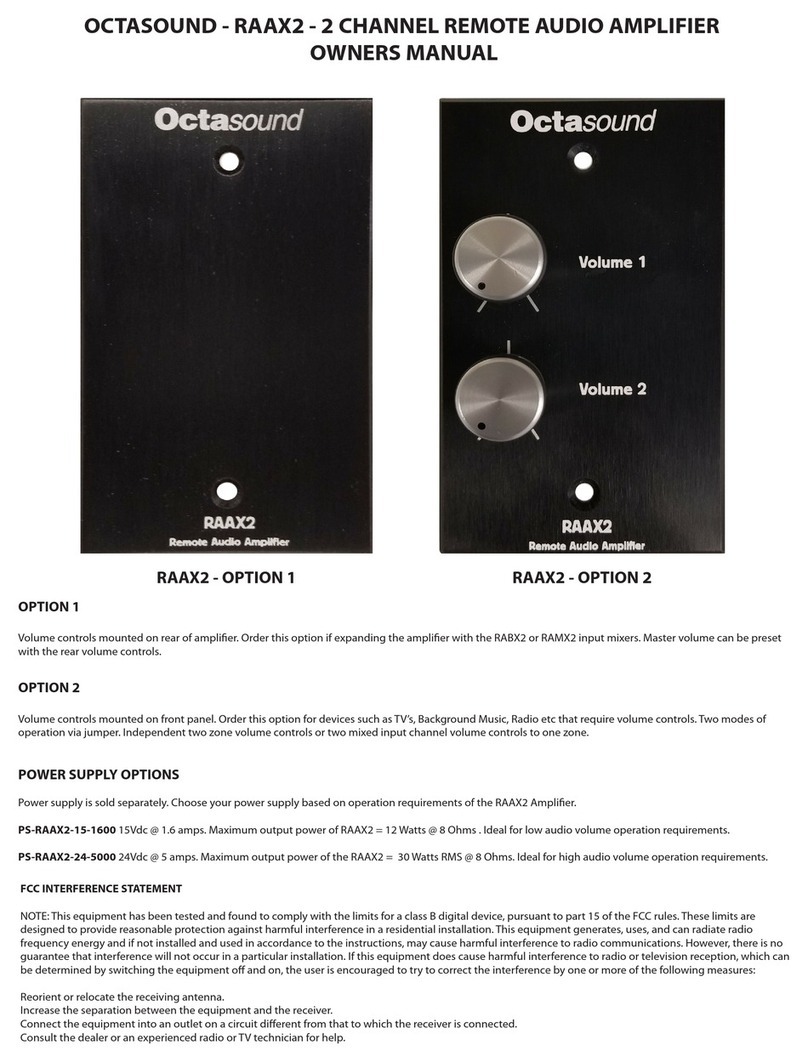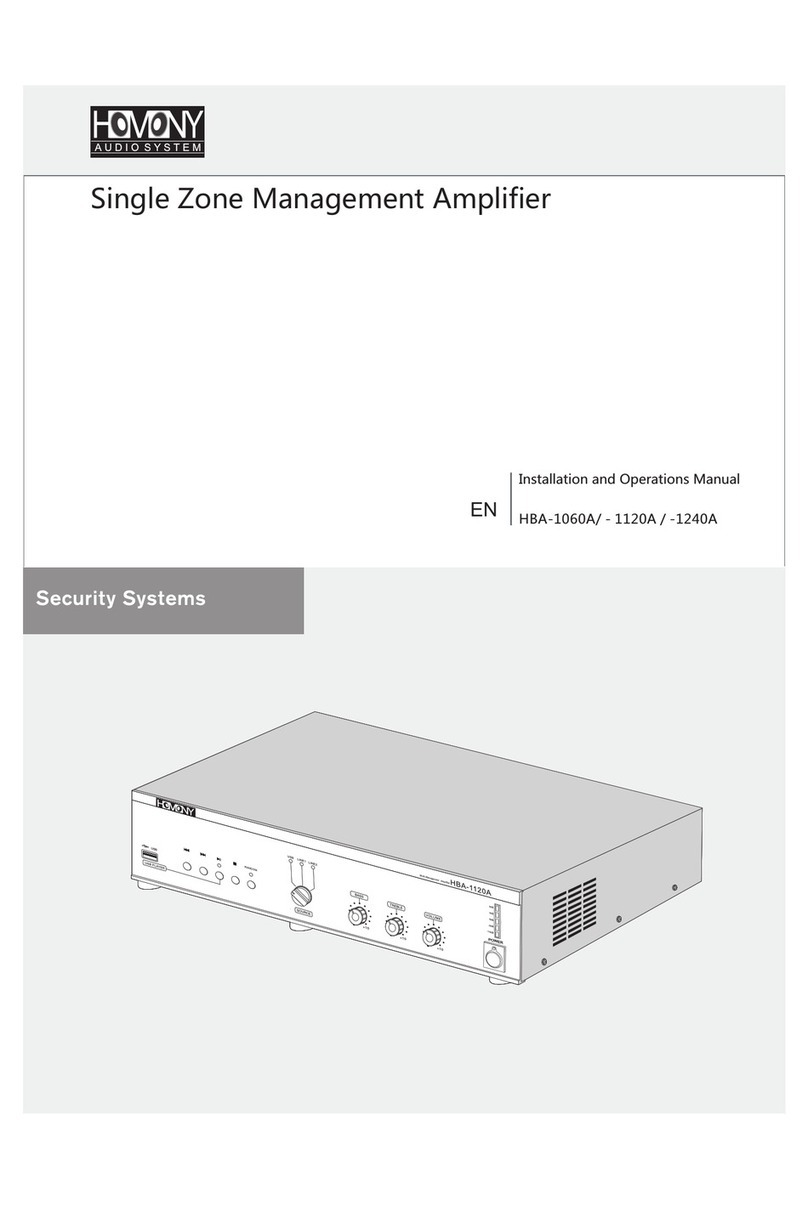iET 1232-A User manual

Operation Manual
Model 1232-A, -AP Tuned
Amplifier&NullDetector
PRECISION INSTRUMENTS FOR TEST AND MEASUREMENT
VIIM-700/cover.p65
TEL: (516) 334-5959 • (800) 899-8438 • FAX: (516) 334-5988
www.ietlabs.com
534 Main Street, Westbury, NY 11590
IET LABS, INC.
© Copyright- 1992

To navigate our easy to use website for quick access to specifications and prices:
1. Select Find a Product to go to a convenient scrolling thumbnail catalog and then to detailed data
sheets as desired; or:
2. Select STANDARDS DECADES STROBES for products formerly manufactured by GenRad (General
Radio) or QuadTech.
Since 1976, IET labs has had a long-standing commitment to conform the instruments and standards we
offer to the customer’s needs rather than to have the customer settle for what is available. We devote our
customer service and applications entirely to the customer’s satisfaction in the quality standards, test instru-
ments and calibration service we provide.
•Combinations of functions, special ranges, ratings, or accuracies.
•Replacement for discontinued models from other manufacturers.
•Calibration and repair services - NIST traceable.
•Compliant with ISO 9001, ISO 17025, ANSI Z540-1-1994, and MIL-STD-45662A.
Capabilities
•R:20 µΩ-1TΩ
•C: <1 pF - 1 F
•L: 100 µH-100H
The World Standard in Metrology
Since 1915
Featuring instruments formerlyFeaturing instruments formerly
Featuring instruments formerlyFeaturing instruments formerly
Featuring instruments formerly
manufactured bymanufactured by
manufactured bymanufactured by
manufactured by
GenRad/General Radio/QuadTech
Now continuing the GenRad tradition
•Accuracy to 1 ppm
•Resolution to 0.1 ppm
•Voltage to 20 kV
•Power to over 1000W
•ProgrammableIEEE-488orBCD

WARNING
OBSERVE ALL SAFETY RULES
WHEN WORKING WITH HIGH VOLTAGES OR LINE VOLTAGES.
Dangerous voltages may be present inside this instrument. Do not open the case
Refer servicing to qulified personnel
HIGH VOLTAGES MAY BE PRESENT AT THE TERMINALS OF THIS INSTRUMENT
WHENEVER HAZARDOUS VOLTAGES (> 45 V) ARE USED, TAKE ALL MEASURES TO
AVOID ACCIDENTAL CONTACT WITH ANY LIVE COMPONENTS.
USE MAXIMUM INSULATION AND MINIMIZE THE USE OF BARE
CONDUCTORS WHEN USING THIS INSTRUMENT.
Use extreme caution when working with bare conductors or bus bars.
WHEN WORKING WITH HIGH VOLTAGES, POST WARNING SIGNS AND
KEEP UNREQUIRED PERSONNEL SAFELY AWAY.
CAUTION
DO NOT APPLY ANY VOLTAGES OR CURRENTS TO THE TERMINALS OF THIS
INSTRUMENT IN EXCESS OF THE MAXIMUM LIMITS INDICATED ON
THE FRONT PANEL OR THE OPERATING GUIDE LABEL.
WARRANTY
We warrant that this product is free from defects in material and workmanship and, when properly used, will
perform in accordance with applicable IET specifications. If within one year after original shipment, it is found
not to meet this standard, it will be repaired or, at the option of IET, replaced at no charge when returned to IET.
Changes in this product not approved by IET or application of voltages or currents greater than those allowed by
the specifications shall void this warranty. IET shall not be liable for any indirect, special, or consequential
damages, even if notice has been given to the possibility of such damages.
THIS WARRANTY IS IN LIEU OF ALL OTHER WARRANTIES, EXPRESSED OR IMPLIED, INCLUD-
ING BUT NOT LIMITED TO, ANY IMPLIED WARRANTY OF MERCHANTIBILITY OR FITNESS FOR
ANY PARTICULAR PURPOSE.


-
1232-A, -AP
Tuned
Amplifier & Null Detector
Instruction
Manual
'1992
Bolton, Massachusetts, U.S.A. 01740-1107
February, 1992
Contents
Warranty
Specifications
Introduction -Section 1
Principles
of
Operation -Section 2
Operation -Section 3
Service and Maintenance -Section 4
j~IEC417
Symbol
L__)
on equipment signifies
that
the manual contains
information to prevent injury
or
equipment damage
®lET LABS, INC.
534 Main Street
Westbury, NY 11590
www.ietlabs.com
516-334-5959
F:516-334-5988
Printed
in
U.S.A. Form1232-0100-00

Contents
Section 1
INTRODUCTION
1.
1 Purpose . • . .
1.2 Description . • •
1.3 Controls
and
Connectors 1
2
1.4
Use
of
External Filters • • 2
Section 2 PRINCIPLES OF OPERATION
21
Preamplifier
of
the Type 1232-A . 3
2.2 Frequency Selective
Amplifier
4
2.3
Null
Network
. . 4
2.4 Amplifier-Compressor 5
25
Meter
Circuit
5
Section 3 OPERATION
3.1
Use
as
an
Amplifier
or
Preamplifier • .
..
6
3.2
Use
as
a Null Detector
for
Bridge
Balancing . . . . . . . 6
3.3
Use
in
Audio
Spectrum Analysis . 7
Section 4 SERVICE
AND
MAINTENANCE
4.1
GR Field Service 8
4.2
Removal
of
Cover . 8
4.3
Battery Installation 8
4.4
Internal Noise . . 9
4.5 Transistor Voltage and Resistance
Measurements . • • • . . 10
4.6 Trimmer-Capacitor Adjustment . 10
4.7 Minimum Performance Standards
11
4.8
Knobs . . • . • • 16
-------
----------·------
Instruction Manual Changes
Specifications, Page iii
Power: Nine mercury cells in series have been replaced by eight
11
AA
11
alkaline batteries, manufacturers part number:
Estimated battery life is
250
hours.
Everready E91
Duracell MN1500
Ray-0-
Vac B15
Service
and
Maintenance,
Paragraph
4.3, Battery
Installation, Page 8
Remove the instrument cover
per
paragraph 4.2, Removal
of
·
Cover.
Remove the old batteries and replace with eight new ones,
installed
per
polarity marking.
Electrical
Parts
List, Page 20
Nine mercury cells have been replaced by eight
II
AA
II
alkaline
batteries, manufacturers part number listed above.

Specifications
TYPE
1232-A
TUNED
AMPLIFIER
AND
NULL
DETECTOR
Frequency Response:
TUNABLE
Fl LTERS:
20Hz
to
20kHz
in 3
ranges;
between
2%
and
6%
bandwidth
to
15kHz;
2nd harmonic
at
least
34
dB down
from
peak, 3rd
at
least
40
dB
down;
rejection
filter
on
two
highest
ranges
reduces 60-Hz level
to
at
least 60 dB below
peak response (50-Hz level
is
down
>50
dB). Dial accuracy
is
±3%.
Fl
XED-TUNED FlLTEAS:
50
kHz, 2nd harmonic
is
44
dB down;
100kHz
...
53 dB down.
FLAT
RESPONSE: ±3
dB
from
20Hz
to
100kHz.
Sensitivity:
See
plot.
Typically
better than
0.1
,.,.v
over most
of
the frequency
range.
Noise Level:
REFERRED
TO INPUT:
See
plot.
Noise figure at 1
kHz
is
less
than 2 dB
at
an
optimum
source impedance
of
27
kn.
REFERRED
TO
OUTPUT:
Less
than 5
mV
on
FLAT
filter-frequency position, min gain setting, and
-20-dB
switch position;
less
than 50
mV
in
MAX
SENS position.
Input:
IMPEDANCE:
Approx
50
kn
at max gain; varies inversely
with
gain
to
1
Mn
at
min gain.
MAX
SAFE
VOLTAGE:
200
V
ac
or
400
V de.
Output:
VOLTAGE
GAIN:
Approx
120 dB on the tunable ranges: 100 dB,
flat
range;
106
dB at
50
kHz;
100
dB
at
100-kHz position.
LEVEL:
1 V
into
10
kn
when meter
indication
is
full
scale.
INTERNAL
IMPEDANCE: 3
kn.
METER
LINEARITY:
dB
dif-
ferences
are
accurate
to
:±5%
±0.1 division
for
inputs
of
less
than 0.3 V. COMPRESSION
(meter switch
to
LOG): Reduces
full
scale
sensitivity
by
40
dB. Does
not
affect
bottom
20010
of
scale.
ATTENUATION
(meter switched
to
-20
dB): Linear response
with
20-dB
less
gain than
MAX
SENS.
Distortion
(filter
switch in
FLAT
position): <5% (due
to
meter rectifiers).
Terminals:
Input,
GR874®coaxial
connector;
output,
binding posts.
Available: 1232-P2 Preamplifier
to
maintain sensitivity
of
1232-A
at
low
frequencies when
operating
from
a source impedance above 100 k.n; rack-adaptor
sets
(see
below) convert
1232 alone,
or
with
companion instruments,
to
19-in. rack-mount
width.
Power:
12
V de;
from
9 mercury (M72) cells in series. Est battery
life
1500 hours.
Optionally,
a rechargeable battery (non-mercury)
can
be
supplied on special order.
Mechanical: Convertible bench cabinet. DIMENSIONS
(wxhxd):
Bench,
8x6x7.5
in.
(203x152x190
mm).
WEIGHT: 5.75
lb
(2.6 kg) net, 8
lb
(3.7
kg)
shipping.
Description
1232-A
Tuned
Amplifier
and
Null
Detector
1232-AP Tuned
Amplifier
and Null Detector,
with
preamplifier
Rack-Adaptor Sets
480-P308,
for
1232-A
alone
480-P316,
for
1232-A
with
1310
or
1311 oscillator
or
similar 8-in. wide instrument
with
convertible-bench
cabinet
480-P317,
for
1232-AP (with preamp) and companion
8-in. instrument
Replacement Battery, 9 req'd
20
I I
I I I
-~~-
10
)EST
~IMIT
Catalog
Number
1232-9701
1232-9829
0480-9838
0480-9836
0480-9837
8410-1372
f--
i':
I
0.
~
••
Fluu.
jCA"
I
I I I
TEST
LIMIT
""i
FULt
\Li
I
v
~.
100
v Minimum
input
for full-
scale
meter
deflection
as
a
function
of
frequency.
0.2
~,_..__,__
I I
0. i I
10
10<01
20
~0
100
200
~
Ike
2
~
10
20
~
100
FREQUENCY
iii

iv
SPECIFICATIONS
(cont)
TYPE
1232-P2
PREAMPLIFIER
(Accessory
supplied
with
Type
1232-AP and
Type
1240-AP
only)
Voltage Gain:
Approx
0.7.
Noise (referred
to
input): Open-circuit equivalent
0.1
pA; short-circuit equivalent, 0.3
p.V
(when
used
with
Type
1232-A tuned
to
100Hz).
Impedances: INPUT:
>100
mn. in parallel
with
70
pF.
OPTIMUM SOURCE: 3 Mn..
OUTPUT:
10 kn..
Connectors:
GR874®on
cables,
input
and
output.
Power:
12
V,
200
p.A, supplied
by
1232-A.
Mechanical: Special cabinet.
DIMENSIONS
(wxhxd):
0.75x6x7.5 in.
(19x152x190
mm).
WEIGHT:
0.94
lb
(0.43
kg)
net, 4
lb
(1.9
kg)
shipping.
Description
1232-P2 Preamplifier
TYPE 1240-A, -AP BRIDGE OSCILLATOR-DETECTORS
Catalog
Number
1232-9602
The Type 1240-A Bridge Oscillator-Detector
is
a rigid assembly of a Type
1311 Audio Oscillator and a Type 1232 Tuned Amplifier and
Null
Detector.
The Type 1240-AP includes the Type 1232-P2 Preamplifier
in
addition
to
the
above instruments. These compact assemblies are convenient for use with audio-
frequency bridges and other null-balance devices.
The units are secured with an Adaptor Plate Set
(PIN
0480-9836 for
1240-A, 0480-9837 for 1240-AP) and bolted together near
the
rear
of
the
instru-
ments. The assembly fits a standard 19-inch relay rack. For bench use, the two
wings of
the
relay-rack adaptor
set
can
be
removed and the
four
rubber
feet
can be installed
in
the corners of the oscil,lator-detector assembly.
Operating instructions for
the
Type 1232-A
or
-AP
Tuned Amplifier and Null
Detector are given
in
this book. A separate instruction book
is
supplied
for
the
Type
1311 Audio Oscillator.
GR 1240-A Bridge Oscillator-Detector.

Introduction-
Section
1
Figure
1.
Type
1232-A Tuned
AmpI
ifier
and
Null
Detector.
1.1
PURPOSE
The Type 1232-A Tuned
Amplifier
and
Null Detector (Figure
1)
is
a
sensi-
tive, low-noise amplifier continuously tunable
from
20 Hz
to
20kHz,
with
addi-
tional fixed-tuned frequencies
of
50 kHz
and
100kHz.
Intended primarily
as
a
bridge detector, the Type 1232-A
can
also
be
used
as
a detector
of
high-frequency
modulated signals
(with
a crystal demodulator), a
wave
analyzer at audio fre-
quencies,
and
a preampIifier
for
transducers.
The Type 1232-P2 Preamplifier
can
be
added
to
improve the signal-to-noise
ratio and consequently the effective sensitivity
of
the Type 1232-A when the
latter
is
to
be
driven
by
very high (greater than 100 kQ) impedance sources.
1.2 DESCRIPTION
The Type 1232-A consists
of
a low-noise preamplifier, afrequency-selec-
tive
stage
(feedback amplifier and null network),
an
amplifier-compressor
stage,
and a meter-rectifier
circuit
(see
block diagram, Figure 2). The total gain
of
the
amplifier
is
about 120 dB. Full-scale meter sensitivity
is
1 microvolt
or
better
over most
of
the frequency
range.
Figure
2.
Functional
diagram of
the
null
detector.
OUTPUT

2
With the Type 1632 Inductance Bridge, this null detector permits induc-
tance balances
to
a resolution
of
1 part in 106• Comparable precision
for
capa-
citance balance
can
be
obtained
with
the Type 1615 and 716 Capacitance
Bridges.
The amplifier
is
powered
by
12 Vdc, supplied
by
nine mercury batteries
in
series.
The
output
is
1 V
into
10,000 ohms.
Front
mountings
are
extendible
to
tilt
instrument face.
The Type 1232-P2 Preamplifier
is
a detachable accessory
that
consists
of
a low-noise field-effect transistor
used
in common-source configuration.
Power
for
the preamp
is
provided
by
the B
+supply
of
the Type 1232-A.
1.3 CONTROLS AND CONNECTORS OF THE TYPES 1232
AND
1232-P2.
Name
FILTER
TUNING
FILTER
FREQUENCY
GAIN
METER
INPUT
OUTPUT
TABLE
1
Type
Function
Continuous
rotary
control
Tunes
fi
Iter within
selected
tuning
range.
6-position
rotary
switch
Selects
desired
frequency
characteristic;
tuning·
frequency
range
of 20-200
Hz,
200
Hz-2
kHz,
or
2-20
kHz;
flat,
50-kHz
or
100-kHz
response.
Rotary
control
3-position
toggle
switch
GR874
Locking
Coaxial
Connector
Turns
instrument
on or off
and
controls
gain.
Selects
full-gain
linear,
-20-dB
linear,
or
logarithmic
response.
Input
terminals.
Pair
of
Type
938
Binding
Output
terminals.
Posts
EXTERNAL
FILTER
Phone
jack
Connection
for
external
fi Iter.
~[HIGH
Z,
LOW
Z
~
INPUT
......
Ill
~
OUTPUT
Toggle
switch
GR874
Connector
and
Cable
Assembly
GR874
Connector
and
Cable
Assembly
Determines
whether
Preamplifier
is
included
in
input
to
Type
1232 (HIGH Z) or
shunted
{LOW
Z).
Input
terminals.
Output
terminals
{to
be
applied
to
INPUT of
Type
1232).
1.4
USE
OF EXTERNAL FILTERS.
Filters
can
be
connected
at
the
EXTERNAL
FILTER
jack. When a tele-
phone plug
is
inserted in this jack, the built-in shunt
filter
is
disconnected. The
external
filter
may
be
either aseries-tuned
circuit
to
trap
out
an
undesired fre-
quency
or
an
antiresonant parallel-tuned
circuit
to
improve the selectivity
at
the desired frequency.
For
the purpose
of
calculating the Q
of
the external
filter,
the source impedance
is
about 700 ohms. Since the external
filter
is
plugged
into
the
circuit
at
a
point
beyond the 60-Hz rejection
filter
and
where there
is
80-dB
gain
to
the meter circuit,
it
is
important
that
the external
filter
be
shielded and
preferably
that
it
use
a toroidal
inductor
for
minimum
sensitivity
to
hum pickup.

Principles
of
Operation-Section
2
2.1
PREAMPLIFIER OF THE TYPE 1232-A.
The preamplifier
stage
of
the Type 1232-A Tuned
Amplifier
and
Null
Detector
is
designed
to
minimize noise
from
both low-impedance sources,
such
as
inductance bridges at
low
frequencies, and high-impedance sources,
such
as
capacitance bridges at
low
frequencies. A transistor
with
a noise figure
of
3
to
5 dB at
an
optimum
source impedance
of
50 kilohms
is
used.
By
use
of
negative
feedback, the
input
impedance
of
the preamplifier
is
also
made
50 kilohms, and
the noise
level
indicated on the
output
meter
is
relatively constant and indepen-
dent
of
source impedance.
The
input
transistor
is
protected from possible
damage
due
to
large over-
loads
by
a
limiter
consisting
of
aseries capacitor
and
two
shunt silicon rectifier
diodes. This
circuit
effectively prevents signals greater than 1 volt, peak-to-peak,
from
reaching the
input
transistor and
does
not
contribute noise
or
distortion
to
low-level signals.
Maximum gain
of
the preamplifier
is
about
40
dB, which
is
adequate
to
swamp the noise
of
succeeding
stages.
After
preamplification, the signal
passes
through a
set
of
series
and
shunt filters, which
are
desig~ed
to
reject frequencies
above
and below the selected tuning
range.
Typical
filter
characteristics
are
shown in Figure 3. On all switch positions except
FLAT
and 20 -200 Hz,
another rejection
filter
reduces the
response
at
60Hz
to
greater than 60 dB
below peak response.
TUNED
FILTER SETTINGS
FREQUENCY
IN
HERTZ
FIXED SETTINGS
Figure
3.
Typical
filter
characteristics
of
the
Type
1232-A.
3

4
2.2 FREQUENCY-SELECTIVE
AMPLIFIER.
This amplifier consists
of
three
stages
with
negative feedback through a
null network, which
has
its null at the desired operating frequency. Since there
is
negative feedback at all frequencies
but
the desired one, the over-all
response
peaks
at this frequency
and
is
roughly equivalent
to
that
of
a tuned circuit
with
a Q
of
about 20
{5%
bandwidth). The unique feature
of
this null network
is
its
one-potentiometer tuning. Many null networks require three variable elements,
either
ganged
capacitors
or
ganged
potentiometers. This
leads
to
many problems
in alignment
and
tracking the three elements
to
maintain a good null. The Hall
null
network
has
a perfect null in theory
for
any position
of
the tuning potenti-
ometer, and
it
is
possible
to
cover a 10:1 tuning
range
with
a40-dB exponential
potentiometer. Tuning capacitors
are
switched
to
change
ranges,
maintaining
the impedance level
of
the null network approximately constant
for
the three
tuning
ranges.
Since the 50-kHz and 100-kHz null networks
need
not
be tunable, con-
ventional
twin-T
null networks
are
used.
On the
FLAT
position
of
the
range
switch, all filters
are
switched
out
and
the frequency
response
is
flat
to
within
±3 dB from 20 Hz
to
100kHz.
The over-
all gain
of
the amplifier
is
reduced by 26 dB
to
keep
the noise level
on
the out-
put meter equal
to
about 10 percent
of
full
scale
at maximum gain.
2.3
NULL
NETWORK.
The Type 1232-A Tuned
Amplifier
and Null Detector
uses
an
RC
null net-
work
with
only
one variable component
to
adjust the frequency
of
the null.
This avoids the
use
of
ganged
variable components, which must track closely
to
maintain stability when
used
in highly selective feedback amplifiers. The net-
work
(Figure 4), consisting
of
three-terminal
RC
circuits,
gives
a complete null
without
being balanced against avoltage divider,
and
permits frequency adjust-
ment
with
a single potentiometer. The tuning law
for
this
circuit
is
·1
wo=
HC
v'
a(
1 -
a)
(1 +
2k)
In order
to
span
a 10-to-1 logarithmic frequency
range,
the potentiometer must
have
an
exponential characteristic
of
over 100
to
1.
I
The selectivity
of
the transfer admittance,
E~
{or y
21
)
is
quite constant
In
U+K)(I+2K)
R
K
~
lt!)R
0
0
Figure
4. Null
circuit
of
the
Type
1232-A
Tuned
Amplifier and Null
Detector.

as
the null frequency
is
changed. In order
to
use
this characteristic, the
network
must
be
driven
by
and loaded
by
low
impedances. Therefore,
it
is
used
in a feed-
back
circuit
with
an
amplifier
having
low
input
and
output
impedances and a
E
transfer resistance -1•0 (or a real z
21
)
that
is
chosen
to
give the desired selec-
m
tivity.
This combination provides a second-harmonic rejection
of
34 dB over
each
10-to-1 frequency range.
2.4 AMPLIFIER-COMPRESSOR.
With
the
METER switch set
to
either linear position, the amplifier-com-
pressor functions
as
a linear amplifier, driving the meter rectifier
circuit
and
supplying the
output
terminals
with
about
1.4 V
for
full-scale deflection
of
the
meter. The
MAX
SENS position'provides
full
gain
for
very
low-level applications.
When
maximum
sensitivity is
not
required,
use
the
LINEAR
-20
dB position
for
a
less
noisy
output.
With this switch setting,
the
noise generated in the
input
and selective
amplifier
stages
is
attenuated. The de supplied
to
the last transistor
is
sufficient
to
drive the
output
meter
to
full
scale,
but
very
little
more,
so
that
it
is
impossible
to
damage the meter
by
overdriving the amplifier.
For
null detector
use,
the METER switch
is
thrown
to
LOG, effectively
compressing
the
upper
part
of
the meter scale.
Two
pairs
of
silicon diodes are
switched
in
shunt
with
the collector resistors
of
two
transistors
to
provide a
nonlinear collector impedance. Owing
to
the voltage offset
of
the silicon diodes,
the
bottom
20
percent
of
the meter
scale
is
virtually
unaffected. A signal level
corresponding
to
100 percent deflection
for
linear response
will
drop
to
50
percent
for
logarithmic response.
An
increase
of
20
dB increases the reading
to
80
percent, and another
20
dB
raises
the reading
to
100
percent.
2.5
METER
CIRCUIT.
The meter
circuit
uses
a full-wave rectifier
in
order
to
double the ripple
frequency
that
passes
through the meter and thus
to
prevent the needle
from
vibrating visibly
at
20 Hz. Resistors are
used
in place
of
two
of
the rectifiers
in the conventional full-wave bridge in order
to
linearize the relation between
meter indication and signal level, and
to
minimize distortion. No de amplifica-
tion
was
incorporated
into
the meter
circuit,
so
that
there
is
no
need
for
a de
zero adjustment on the
front
panel and
no
possibility
of
de zero instability.
High-impedance, crystal-type earphones
can
be
connected
to
the
output
termi-
nals.
5

6
Operation-Section
3
3.1
USE
AS
AN
AMPLIFIER
OR PREAMPLIFIER.
To
use
the Type 1232-A
or
-AP Tuned
Amplifier
and Null Detector
as
an
amplifier:
a.
Connect the
input
signal
to
the INPUT connector
of
the Type 1232 or,
if
used,
the Type 1232-P2. Adaptors
for
connectors other than Type 874
are
available
from
General Radio.
If
the
output
impedance
of
the source
of
this signal
is
greater than 100 k!2,
set
the switch on the Type 1232-P2,
if
used,
to
HIGH Z;
otherwise
set
the switch
to
LOW
Z.
NOTE
For connection
to
binding posts,
use
a Type 874-R34
Patch
Cord. (Hum pickup
is
too
great
with
aType
874-Q2 Adaptor.)
b. Set the METER switch
to
LINEAR
-20
dB
(unless maximum
sensi-
tivity
is
required.)
c.
Set the
Fl
LTER FREQUENCY switch
for
the desired characteristic:
FLAT,
20-200 Hz,
200Hz-2kHz,
2-20kHz,
50 kHz,
or
100kHz.
d. With the
GAIN
control, turn the instrument on and adjust the gain
to
the desired level. The total
range
of
the
GAl
N control
is
120 dB, and attenu-
ation in dB
is
roughly proportional
to
the rotation angle
of
the control knob.
e.
The OUTPUT terminals may
be
connected
to
an
oscilloscope
or
head-
phones. The
red
binding post
is
high, the black binding post
is
ground.
The high sensitivity
of
this instrument permits its
use
as
a preamplifier
for
transducer outputs
or
oscilloscope input.
3.2
USE
AS A
NULL
DETECTOR FOR BRIDGE
BALANCING.
To
use
this instrument
as
a detector
for
bridge measurements;
a.
Connect the INPUT terminals
of
the Type 1232-A
or
-AP
to
the
DETECTOR terminals
of
the bridge
as
in paragraph 3.1, step
a.
b. Set the METER switch
to
LOG.
c.
Set the
Fl
LTER FREQUENCY and Fl LTER
TUNING
controls
to
the
desired frequency.
d. With generator and unknown connected
to
the bridge, set the
GAl
N
control
of
the Type 1232-A
for
approximately half-scale deflection
of
the out-
put
meter, and tune the FlLTER
TUNING
control
for
maximum
output.
The bridge balance
can
now
be
made
in the conventional manner,
by
re-
adjustment
of
the
GAIN
control
as
balance
is
approached.

3.3
USE
IN
AUDIO
SPECTRUM
ANALYSIS.
The tuned amplifier
can
be
used
as
an
audio-frequency wave analyzer
with
asensitivity
of
1
p.V
and
a bandwidth
of
about 5 percent.
For
approximate
measurements, the gain
can
be
assumed
to
be
constant
with
frequency. More
accurate measurements
can
be
obtained
if
the amplifier
is
first
calibrated
with
a
constant-amplitude, variable-frequency signal. The typical variation
of
peak
response
vs
frequency
is
shown in Figure
5.
+10
CONSTANT
CURRENT
SOUR.::E
~---
---
-
......
r--s~~
.........
,..,.---
-
........
-
...
,
~·
-
/ ' / '
~rjf
'
0
r
7-
CONSTANT VOLTAGE
SOURCE-<!__..,.
-10
CONSTANf
CURR~NT
SOU~CE
.-!!!_
--"'
-20
-30
20
50 100 200
500
10
20
50
100
FREQUENCY-
HERTZ
Figure
5.
Typical
variation
in peak
response
with
frequency
for
constant
gain-control
setting·.
7

8
Service
and
Maintenance-Section
4
4.1
GR
FIELD
SERVICE.
Our warranty attests the
quality
of
materials
and
workmanship in
our
products. When difficulties do occur,
our
service engineers
will
assist in any way
possible.
If
the
difficulty
cannot
be
eliminated
by
use
of
the following service
instructions,
please
write
or
phone the nearest GR service
facility
(see
back page),
giving full information
of
the trouble and
of
steps taken
to
remedy
it.
Describe
the instrument
by
type, serial, and
ID
numbers. (Refer
to
front
and rear panels.)
Before returning
an
instrument
to
General Radio
for
service,
please
ask
our
nearest office
for
a "Returned
Material"
number.
Use
of
this number in
correspondence and on a tag tied
to
the instrument
will
ensure proper handling
and
identification.
After
the initial warranty period,
please
avoid unnecessary
delay by indicating
how
payment
will
be
made, i.e.,
send
a purchase-order num-
ber
or
(for
transportation
charges)
request
"C.O.D."
For return shipment,
please
use
packaging
that
is
adequate
to
protect the
instrument
from
damage, i.e., equivalent
to
the original packaging. Advice may
be
obtained
from
any
GR
office.
4.2
REMOVAL
OF
COVER.
To
open the instrument
for
access
to
transistors and components, loosen
the
two
fluted captive screws at the rear
of
the instrument and slide the U-shaped
dust cover away
from
the panel.
All
transistors and components
are
now
accessible.
4.3
BATTERY
INSTALLATION.
The Type 1232-A Tuned
Amplifier
and Null Detector
is
powered
by
nine
M72 mercury batteries (Mallory RM-4R
or
equivalent), which
will
last
for
over
1500 hours
with
normal
use.
For a simple check
of
the batteries, measure the
de
voltage between anchor terminal 6 and ground. This should
be
12
V.
To
replace the batteries, remove the cap
(twist
counterclockwise and pull
out) on the right-hand side
of
the instrument under the M72 CELLS engraving.
Insert the
1%
in. spacer (P/N 1232-6010) in the opening on the right-hand side
of
the instrument, under the M72 CELLS engraving.
Push
it
in
to
the
end
of
the
compartment. Then, insert the nine batteries
with
the positive(+) terminal
as
marked on the battery facing
into
the instrument. Finally place the cap (battery-
keeper assembly, P/N 1650-2120) in position, twisiting
it
approximately%
turn
in either direction
to
lock
it
in position.

4.4
INTERNAL
NOISE.
4.4.1 Noise Indicated
by
Meter.
At
certain frequencies the sensitivity
of
the Type 1232-A Tuned
Amplifier
and
Null Detector greatly exceeds the catalog specifications. With maximum
gain
at these frequencies, the noise generated by transistor Q100 normally
causes
large deflection
of
the
output
meter. For maximum useful gain, the
GAIN
control
should
be
set low enough
so
that
the noise level at the
output
is
not
greater
than 10 percent
of
full
scale.
For minimum sensitivity
to
hum pickup
and
stray fields,
input
connec-
tions must
be
shielded. Do
not
use
an
adaptor from the Type 874 INPUT con-
nector
to
binding posts;
use
a shielded Type 874 cable.
If,
with
completely shielded
input
connections, the noise level
of
the
Type 1232-A greatly exceeds the
values
given in Figure 6, the noise
is
probably
caused
by Q100.
If
it
is
necessary
to replace this transistor, a replacement
with
a high
{3
(beta)
will
usually give the lowest noise levels.
It
is
possible,
but
not
likely,
that
Q1
01
will
contribute significantly
to
the
internal noise.
4.4.2 Noise From the Type 1232-P2.
The equivalent noise sources
of
the Type 1232-AP
with
the
FILTER
FREQUENCY set
to
100
Hz
are
a current source
of
less
than
0.1
p.p.A
and a
voltage source
of
less
than 0.3 p.V.
If
the noise levels
of
the Type 1232 alone do
not
exceed the
values
of
Figure 6, yet the Type 1232-AP
will
not
meet the
above specifications, replace the transistor in the Type 1232-P2.
..J
w I
~;;
0.5
..Jo..
w~
6~
0.2
~8
0.1
5~
.....___
I I
SHORT-CIRCUIT /
NOISE
~V
i\.
..,~
"
.......
~
) /
'l
"'
./
~
~
~
~-CIRCUIT
j
~~
0.05
._!.a::
~~
0.02
~---
(/)
:>.01
lOHz
20
50
100
200
500
IkHz 2
FREQUENCY
NOISE
pA
I I
5
10
20
100
Figure
6.
Typical
noise
)e..vels
as
a
function
of
frequency.
4.4.3
Output
Noise.
Due
to
the
large
amount
of
amplification
that
follows the
GAIN
control
there
is
always a small amount
of
noise present
at
the OUTPUT terminals.
At
minimum gain,
and
with
the
FILTER
FREQUENCY control set
to
FLAT
or
with
a
FlLTER FREQUENCY
of
5kHz
or
lower, this noise should
be
less
than 50
mV
with
the METER switch set
to
MAX
SENS
and should
cause
no more than 1 per-
9

10
cent deflection
of
the
output
meter. With the METER switch set
to
LINEAR
-20
dB, this noise should
be
less
than 5
mV.
If
the noise
is
greater than 50
mV
with
minimum gain
and
MAX
SENS
switch setting, the trouble
is
probably
caused
by
0200, 0201,
or
0202.
If
this
noise level
is
less
than
50
mV
and the noise
with
LINEAR
-20
dB switch setting
is
greater than 5
mV,
the
faulty
component
is
probably
0203, 0204,
or
0205.
4.5 TRANSISTOR VOLTAGE
AND
RESISTANCE MEASUREMENTS.
Table 2 gives the normal voltage and resistance measurements
from
transis-
tor
terminals
to
ground. A deviation
of
10 percent
from
any
of
these values
is
not
necessarily abnormal.
1.
Before making transistor voltage measurements, make sure
that
the bat-
tery
voltage
is
approximately 12 V (refer
to
paragraph 4.3). Turn the instrument
on
but
leave
the
GAIN
control counterclockwise, set the
Fl
LTER FREQUENCY,
switch
to
FLAT
and the METER switch
to
LINEAR
-20
dB. Measure voltage
with
a high impedance voltmeter.
2.
Before making resistance measurements, remove all the batteries and
short-circuit anchor terminal 6
to
ground. Remove ail transistors. Set the
GAIN
control
to
OFF,
the Fl LTER FREQUENCY switch
to
FLAT,
and the METER
switch
to
LINEAR
-20
dB.
Transistor
Term.
(Type)
Q100 c
E
B
· Q101 c
E
B
Q200 c
E
B
Q201 c
E
B
QlOl
of
D
Type 1232-P2 s
G
TABLE 2
VOLTAGES
AND
RESISTANCES
De
Volts
Ohms
To
Transistor
To Ground Ground (Type)
7.8
222 k
0202
3.6 220 k
3.7 3.3 M
11.6 2.2 k
Q21)3
7.7
40 k
7.8
222 k
7.4
34 k Q204
3.6
33
k
3.7 120 k
3.3 22 k Q205
7.8
23 k
7.4
34
k
12.0
Term. De
Volts
To
Ground
c 0
E 3.5
B 3.3
c 1.7
E
0.4
B 0.5
c
3.6
E 1.6
B
1.7
c
7.2
E 3.5
B 3.6
3.2 k
0.7 to 2.5
lOk
* Impedance
too
high
to
permit
* 1 G
measurement.
4.6 TRIMMER-CAPACITOR ADJUSTMENT.
Ohms To
Ground
0
llk
22 k
100 k
4.7 k
42 k
47 k
10 k
100 k
4.4
k
3.3 k
47 k
Normally, the factory-set
trimmer
capacitor adjustment (C202)
will
not
require attention. However, adjustment may
be
necessary
if
transistor
0201,
Q203,
or
Q204 is replaced.
If
the frequency response
for
the
FLAT
characteris-
tic
is
outside the specified limits, adjust the
trimmer
capacitor
as
follows:

a.
With the
FILTER
FREOUENCY switch
set
at
FLAT
and
a 1-kHz
sig-
nal at the INPUT connector, adjust the
GAIN
control
for
a 5-dB meter indica-
tion.
b.
With the
GAIN
and
Fl LTER FREQUENCY controls unchanged, apply
a 100-kHz signal
(of
the
same
amplitude
as
the 1-kHz signal)
to
the INPUT con-
nector and adjust the
trimmer
capacitor, C202,
for
a meter indication
of
5 dB.
Check the frequency
response
below
100kHz
to
make
sure
it
is
within
the
specified limits.
c.
With
same
settings,
use
continuously variable source
to
check
that
response
is
flat
within
±3 dB
from
20 Hz
to
100 kHz. Adjust
with
C202,
if
necessary.
4.7 MINIMUM PERFORMANCE STANDARDS.
4.
7.1
General
The
following
tests
are
provided
to
demonstrate compliance
of
the 1232-A
with
published specifications at incoming inspection
or
following repair
or
calibration.
4.7.2 Test Equipment
The items listed in Table 3
are
recommended
for
performance
of
the
ensuing tests.
Table 3
Instrument
Recommended
Type*
Decade
Voltage Divider
GR
1455-B
Counter
GR
1192-B
Coaxial Adaptor
GR
874-010
Patch
Cord
GR
776-A
Patch
Cord
GR
776-B
Patch
Cord
GR
274-NP
Shielded
Patch
Cord
GR
874-R34
Oscillator
GR
1310-B
Voltmeter hp 400E
Short-Circuit Termination
GR
874-WNL
Open-Circuit Termination
GR
874-WO
Insertion
Unit
GR
874-X
5.1
Mn
resistors,
5%
(2 required)
•or
equivalent.
4.7.3 Noise Check
Connect the Voltmeter
to
the 1232-A OUTPUT terminals (via the
776-A Patch Cord and
set
controls
as
follows:
a.
Voltmeter RANGE switch
to
0.1
volts.
b. 1232-A METER switch
to
MAX
SENS.
c.
1232-A
FILTER
FREQUENCY switch
to
FLAT.
d. 1232-A
GAIN
control on,
but
fully
ccw.
The voltmeter indication (noise) should be .03-V maximum.
11

12
4.7.4 FilterTuning Dial.
Connect equipment
as
shown in Figure 7.
Set controls
as
follows:
a.
Set
oscillator
to
1 kHz at 1 V output.
b.
Set
1455-B
to
.00100
(1
mV output.)
c.
Set 1192 in FREQUENCY mode.
d.
Set
1192
range
switch
to
1 sGATE TIME.
e.
Set
1192 DISPLAY control at 1
s.
f. Set 11921NPUT
ATIEN
at
1:1.
g.
Set 1232-A FILTER FREQUENCY switch
to
200Hz-2kHz.
h.
Set
1232-A METER switch
to
MAX
SENS.
Set
the FlLTER TUNING dial
on
the 1232-A
to
each
of
the numbered points
(2,
3,
4,
5,
7,
10, 15, 20)
and
adjust the 1232-A
GAl
N
and
the 1310 frequency
for
a
peak
reading on the 1232-A meter. In
each
case,
the frequency
read
on
the 1192
should
be
within ±3%
of
the nominal value
on
the 1232-A
FILTER
TUNING
dial.
(See
Table 4).
Table 4
OSCILLATOR FREQUENCY SETTINGS
Hz
Hz
194-206 679-721
291-309 970-1030
388-412 1455-1545
485-515 1940-2060
Repeat the test at
100Hz,
20Hz,
and
200Hz
on
the 20-200 Hz
range,
and
at
2,
10, and 20 kHz on the 2-20 kHz
range.
Also check 50- and 100-kHz
(via the 1232-A FILTER FREQUENCY switch). In
each
case
set the switch
to
its proper position before setting the frequency. The Fl LTER TUNlNG dial
is
not
in the circuit at 50-
and
100kHz.
At
each
step the
FILTER
TUNING
dial
should
be
accurate
to
within
±3%
of
the frequency
read
on the 1192.
4.7.5 Frequency
Response
Set the following controls
(same
set-up
as
above):
a.
Set
oscillator
to
1 kHz at 1 V
output.
b.
Set
1455-B to .01000
(1
0 mV.)
c.
Set 1232-A FILTER FREQUENCY switch
to
FLAT.
GR 1310.8 GR 1455-B
GR
1232·A
GR
874·A34 INPUT OUTPUT
r
-o-+---+-o
GR
274-NP
GR
874-010
GR 1192-B
GR
776-B
L------+-o
A
1232-28
Figure
7.
Filter Tuning Dial Test Set-up.
This manual suits for next models
1
Table of contents

